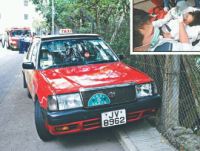A couple more pedestrians died yesterday in road accidents. Although such fatalities are probably no more frequent in Hong Kong than in many other big cities, the reasons are different. First is the mysterious and in many ways wondrous nature of our vehicles – notably taxis and minibuses – which have a rebellious and malicious will of their own and often ‘go out of control’ for no apparent reason other than spite for their human masters. The other is that, unlike in other communities, our transport bureaucracy has an official policy of killing (or strictly speaking facilitating the killing of) people who selfishly use up valuable highway space by walking.
 A perfect example of this is revealed in the photo in today’s Standard showing the site on Kennedy Road of one of yesterday’s deaths. The 18-inch wide concrete ridge on which the taxi has come to rest is not merely a base for the fence; it is the sidewalk. As a resident is quoted as saying: “you fear [cars] will brush against you.” The narrowest-shouldered, slimmest individuals will be in danger – even when the vehicles are not suffering from violent mood swings – if someone else comes along and they need to pass.
A perfect example of this is revealed in the photo in today’s Standard showing the site on Kennedy Road of one of yesterday’s deaths. The 18-inch wide concrete ridge on which the taxi has come to rest is not merely a base for the fence; it is the sidewalk. As a resident is quoted as saying: “you fear [cars] will brush against you.” The narrowest-shouldered, slimmest individuals will be in danger – even when the vehicles are not suffering from violent mood swings – if someone else comes along and they need to pass.
The decision to make the sidewalk so narrow was made by a civil servant implementing a policy, and that policy is to accept pedestrian deaths in order to keep the traffic flowing. This is an extension of the policy to treat traffic in Hong Kong as a natural phenomenon beyond the control of mankind: though its course can be diverted here and there, its volume – which usually rises year after year – is no more manageable than the lava flows that ooze out of the ground in Hawaii and Iceland.
It is not a coincidence that the Transport and Housing Bureau responsible for this approach is the same part of government that thinks 400 square feet is sufficient for a family to live in and HK$69 billion is a sensible price for a 16-mile stretch of rail track. It is not the only part of the bureaucracy heavily populated by psychopaths – the planning and lands function of the Development Bureau is stuffed with them – but its malevolence towards citizens has a higher profile.
Interestingly, these two bureaus are involved in a power struggle in Kennedy Road. Transport officials naturally want to keep pedestrian numbers down through a high mortality rate caused by vehicles traveling at speed. The planners, however, have a different agenda. Their priority is to kill off a larger number of people more slowly through increasing air pollution.
To this end, they have authorized the construction of Hopewell Holdings’ famous mega-hotel just down the hill. As (rather whiny) residents have pointed out, the structure will block airflow and create traffic gridlock; when the tower is built, people walking in the neighbourhood will be squeezing their way through almost-stationary vehicles crawling along at the speed of molten rock. Thus the planners will come out on top and rot people’s lungs with suspended particulates over many years, while the transport officials will have no choice but to lose face and abandon their favoured ‘instant death’ solution. Just another of those interdepartmental squabbles that make government so interesting.

It’s a very HK story.
Narow footpaths because the only people using it are domestic helpers walking dogs etc. All other residents (gweilos, bananas, civil servants) have their own car, hence little political pressure to make any changes.
Taxi’s and mini-buses operate with impunity. To scold/punish those who break the law is to ‘deny their right to earn a living’. Witness similar indignation (even by politicians) after mini-bus drivers run red lights and cause injury, or, alternatively, van drivers attempting to pick up passengers at the arrival hall at CLK.
The solution will be a boon for civil servants, massive civil engineering and slope development to widen the footpath.
The Netherlands government does many stupid things, but one thing they have got right in my opinion is the “law of the weakest” on the road. i.e. no matter who is really at fault it is presumed that the “weakest” member of the traffic chain is not at fault. So if you’re a pedestrian, you have more rights than a bicycle, a cyclist, more rights than a motorbike, then trams, then cars, then buses, then trucks and lorries.
OK, I hear legco falling off their chairs in laughter. But it’s worth a thought!
Hong Kong taxi and red minibus drivers are no different than criminals to me. They all think they are Formula 1 drivers. They think they own the road. They drive without a care in the world only care about themselves. Their excuses of “making a living” rings hollow. If you break the law to earn a living by illegally speeding, how different are they from criminals? Frankly, I feel no sympathy for those red minibus or taxi drivers imprisoned for traffic offenses, they deserved it!